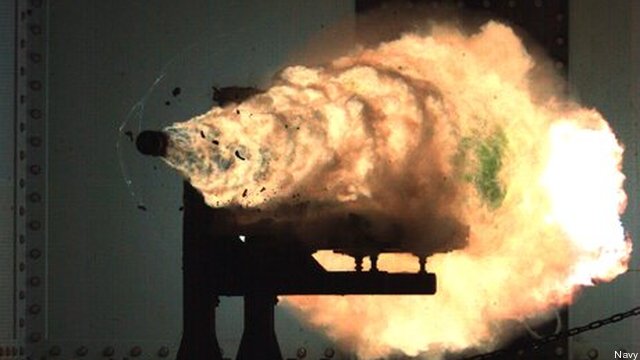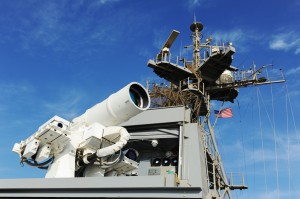Hill To Navy: Hurry Up On Rail Guns, Lasers
Posted on

Navy rail gun test
WASHINGTON: Rail gun bullets move seven times the speed of sound. Laser beams fire at the speed of light. But Pentagon procurement? Not so fast. But with both Congress and the Navy Secretary expressing impatience, the Navy is accelerating its efforts to move both lasers and rail guns from the test phase into the fleet.
“We’ve got a laser weapon now in the Arabian Gulf, we’ve got a rail gun under development,” Sec. Ray Mabus said Thursday at the National Press Club. “We’ve got some gee-whiz scientific stuff going on. Part of my job, part of our job, is to get those from the lab to the warfighter quicker….That rail gun, we’ve been working on that since the eighties; we’re gonna put it on a ship and test it next year,” with operational deployment sometime in the future. That timeline, Mabus said, is “way too long.”

The Navy’s Laser Weapons System (LaWS) aboard the USS Ponce in the Persian Gulf
Congress agrees. Just hours before, the House Armed Services Committee had passed its draft of the annual defense policy bill. Included: a provision that “directs the Secretary of the Navy” — that’s Mabus — “to develop a plan for fielding electric weapon systems” — meaning both lasers and rail guns, which rely on electric power rather than gunpowder — “and to provide a briefing on the results of this plan to the House Committee on Armed Services by March 1, 2016.”
“I like the legislation,” Center for Strategic and Budgetary Studies senior fellow Mark Gunzinger told me today. “It says, ‘let’s move to actually establishing programs to deliver these capabilities instead of keeping them in the S&T world.'” (Science and Technology is the Pentagon term of art for research not tied to a specific piece of equipment the military plans to buy). Currently, he said, “they’re all S&T projects, [and]we need to transition them into the acquisition process.”
“Within two to three years, we could actually have operational directed energy weapons [i.e. lasers] on ships, at our forward bases, even perhaps ones that would accompany our maneuver forces in the field — if there was funding,” Gunzinger said. (A rail gun, he said, is more like 10 years away). At roughly $500 million a year across the defense Department for multiple S&T projects, “there’s been adequate funding for what they’ve done,” he said. “There’s been inadequate funding for testing these technologies,” let alone fielding them.
So what’s the current schedule? For all their similarities, lasers and rail guns are very different technologies on very different timelines. A laser consumes electricity and shoots out light. An electromagnetic rail gun also consumes electricity, but it shoots out a physical object, in the Navy version a 23-pound metal slug. A rail gun round impacts much more forcefully than any laser beam: That allows it to take down tougher targets like reentry-hardened ballistic missile warheads, whose heat shields would simply soak up a laser blast. But the physical projectile requires much more energy to launch, plus all the recoil-absorbing apparatus of a conventional cannon.
As a result the rail gun is bigger, heavier, and not as far along. Physical wear and tear on the barrel remains a major concern for rail gun development, Rear Adm. Mathias Winter, the new Chief of Naval Research, said. The weapon’s been tested so far at low rates of fire, allowing time for the barrel to recover, he said, while defense against incoming missiles might take 10 shots a minute for minutes at a time.
“We still need to do that science,” Winter told me in a sidebar conversation at April’s Sea-Air-Space conference. On the upside, he went on, thanks to advances in power and cooling, the physical size of the rail gun has come down “over fifty percent [since] about five, seven years ago.”
Next year, the Navy will put a prototype rail gun on a support ship, the Joint High Speed Vessel Trenton. JHSVs are fast, light, unarmed transports, and as transports they have lots of room. The rail gun itself will go on the deck while electrical generators and other equipment will take up the cargo bay.
Meanwhile, the Navy already has a 30-kilowatt Laser Weapon System (LaWS), powerful enough to shoot down drones and disable fast attack boats, installed on a ship in the Persian Gulf. But, again, the ship in question is a transport, specifically the Afloat Forward Staging Base Ponce. The AFSB is a repurposed amphibious assault ship, designed to carry a Marine landing force with all its vehicles and gear, so again there’s plenty of room.
An aircraft carrier has similar leeway for lasers, especially the new Ford-class flattops. Most warships are packed much tighter. What’s more, with power-consuming systems like jammers, radars, and other sensors advancing more rapidly than power-generating systems, warships rarely have much spare electrical power, either.
The big exception is the DDG-1000 Zumwalt class, the Navy’s new high-tech destroyer. A DDG-1000 actually turns its propellers electrically, rather than with a mechanical shaft attached to the engine, so it has plenty of power to spare when not moving at maximum speed.
In fact, the chief of Navy Sea Systems Command (NAVSEA), Vice Adm. William Hilarides, has said publicly that his staff is studying installing a rail gun on the third DDG-1000 to be built. That would be the USS Lyndon Johnson, which is scheduled for delivery in 2018. (The first two ships are too far along). Because the ship has less spare room and weight than it has power, the rail gun will probably replace one of the destroyer’s two conventional 155 millimeter cannon.
The problem with putting a rail gun on the third DDG-1000 is that ship will also be the last in its class. The Navy decided the DDG-1000s are too expensive and truncated the buy at three, preferring to resume production of its workhorse DDG-51 Arleigh Burke destroyers. So the vast majority of the Navy’s destroyers are and will continue to be variants on a 1980s design, one packed tight by decades of upgrades.
“I don’t think a rail gun on the DDG-51 makes much sense,” said Bryan Clark, a retired Navy commander and former top aide to the Chief of Naval Operations, who now works with Gunzinger at CSBA. But lasers, he said, are entirely doable.
Next year, the Navy will buy its first Flight III Arleigh Burke destroyer, a majorly modernized model with a powerful and power-hungry new radar. To run the radar and other high-tech systems, the Flight III is being built with a lot more capacity to generate electricity than previous versions of the DDG-51. By Clark’s calculations, a Flight III could run its radar at full power and simultaneously blaze away at incoming cruise missiles with a 400-kilowat laser. That’s 16 times as powerful as the prototype now in the Persian Gulf.
Even existing Arleigh Burkes could manage a laser, Clark said, although they couldn’t fire continuously without turning down other power-hungry systems like the radar. As for physical space and weight, he said, the laser would not have to replace the destroyer’s deck gun. Because the bulk of the laser system can be taken apart into different modules and packed wherever they fit aboard the ship, as long as they’re appropriately wired together, he said, “the only piece that’s actually on the deck is the beam director.”
The Navy is now developing a laser they can fit on a destroyer. “It’s still S&T,” Rear Adm. Winter caveated, but the goal is to test-fire the weapon in fiscal 2017. The platform wouldn’t be an operational destroyer, but a retired one now in use as a test ship for self-defense systems. It’s not exactly representative of an Arleigh Burke, Winter acknowledged, but it’s a lot closer than the USS Ponce or a JHSV.
But Congress‘s question remains unanswered, for now: When will the Navy get these weapons on actual warships?
Subscribe to our newsletter
Promotions, new products and sales. Directly to your inbox.
